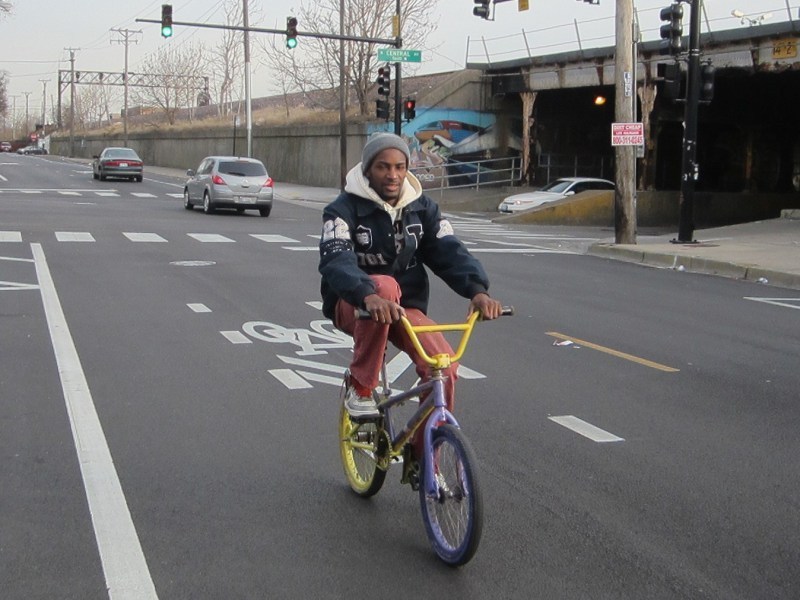The Active Transportation Alliance recently released the second of a series of findings from its listening tour of communities of color on the South and West sides. The most recent tour was conducted with West Side elected officials and community leaders regarding transportation and mobility challenges during COVID-19. ATA spoke with two aldermen, one bike shop owner, and many people from community organizations. This report focuses on transit, biking, access to safe walking and recreation, community safety, and access to resources.
Transit
The Green and Blue Lines are important assets on the West side. The fact that CTA has continued to run at regular levels of service during the pandemic was crucial for essential commutes. However, there are concerns about accessibility for seniors and folks with disabilities, crowding on buses and personal security while waiting at bus stops Austin residents were specifically concerned about being impacted by violence while waiting for the bus.
Community Safety
Per the report, community safety emerged as a common theme. Garfield Park and Austin residents voiced concerns about public safety along with concerns about over-policing. Austin residents are working to address an uptick of violence associated with the pandemic.
Access to Walking and Recreation
In Garfield Park, community leaders ATA spoke with do not see a special need for more room for walking and biking during COVID. West Side Residents are say Douglas, Franklin, and Humboldt Parks being used for recreation, but overcrowding is not an issue. One reason for a lack of crowding on sidewalks on the West Side is due to a lack of bustling commercial corridors. However, West Siders would like to see speeding curtailed, sidewalks and potholes repaired, and more access created for people with disabilities and other mobility challenges.
Biking
West Siders ATA spoke with do desire more opportunities for safe recreational biking. Some folks mentioned making the boulevards safer for biking (no ideas were listed in the ATA piece.) One idea I’d love to see implemented across the city is traffic calming baked into our side streets. The issue with our current "neighborhood greenways," traffic-calmed side-street bike routes, is that greenways create a sort of special design for a segment of a side street when all of our side streets should be designed for slow driving speeds and safe cycling.
I believe some of the harassment I've experienced on the Glenwood/Greenview Greenway in my neighborhood of Rogers Park is due to the lack of traffic calming on other side streets. If drivers are used to doing 30 MPH in a 20 MPH zone or simply 30 MPH (the default speed limit on Chicago’s streets), having a few speed humps and traffic circles here and there won’t necessarily be enough to change drivers' habits.
I would also love to see chicanes become common in Chicago. I think these could work well on Chicago’s boulevards by creating an environment that makes it difficult to overtake cyclists, twiddle with your cell phone, or drive at unsafe speeds.
Per ATA’s report, “Austin and North Lawndale lack bike lanes and other types of infrastructure to make biking a realistic option for residents.” Despite the dearth of infrastructure, one Austin resident has noted an increase in biking in Austin since the pandemic.
Concerns about personal security also impact whether West Siders feel comfortable hopping on a bike. The report noted worries about traveling into gang territory influence the decision to ride a bike or not. Additionally, access to bikes is an issue at this time because the current bike boom is growing demand and COVID-19 has disrupted supply chains.
Access to Resources
In Austin issues accessing groceries is ongoing given that many small stores in the area were looted during the recent civil unrest. Child care and resources to assist with the processing and healing of trauma are also needed. Some residents in Humboldt Park struggle with access to food and the internet. Lastly, homelessness was cited as an issue. When asked how transportation advocates can help, a resident stated supporting existing efforts on the frontline would be helpful.
Personal Reflections
Any time I read about concerns about community violence, it made me think of my interview with Warren Logan, and Oakland, California, planner who helped pilot the Slow Streets concept, roadways where through traffic is banned to make room for socially-distanced walking and biking. The Oakland Department of Transportation has also collaborated with community organizations to increase the safety of marginalized people traveling on the street, for example, working to reduce incidents of catcalling or street harassment.
Black Lives Matter Chicago has been calling for police funding to be shifted to community organizations working to provide anti-violence services and meet residents' basic needs. This can be an opportunity for the Chicago Department of Transportation, the CTA, and Pace Suburban Bus to think more expansively about their work and partner with community groups to respond to transit riders' and cyclists' concerns about interpersonal violence while traveling our city’s streets.
If the city of Chicago wants to decrease its emissions, getting more folks walking, biking, and using public transportation needs to be a top priority. We must look at all the factors that are preventing people from using more sustainable modes of travel and work to address those issues.
Follow Courtney Cobbs on Twitter at @CourtneyCyclez.




